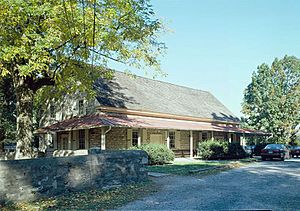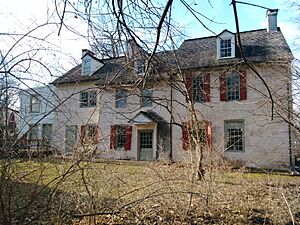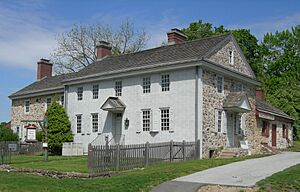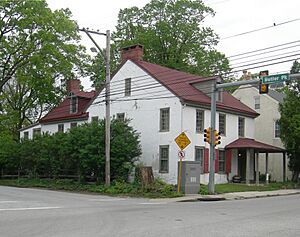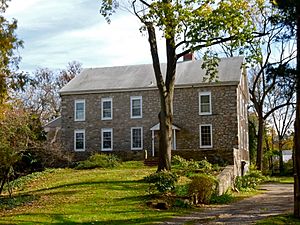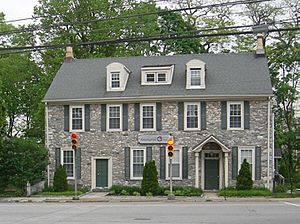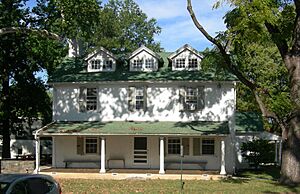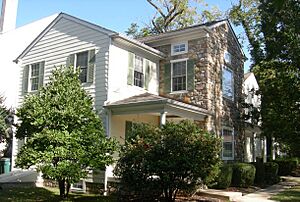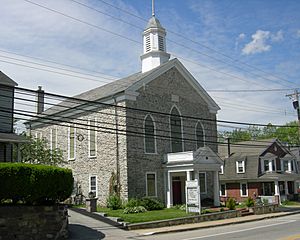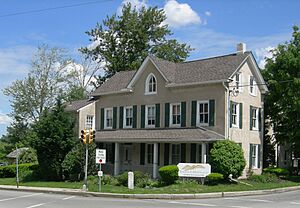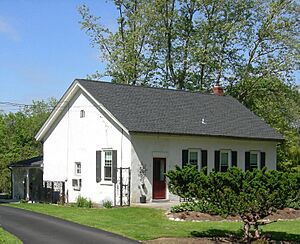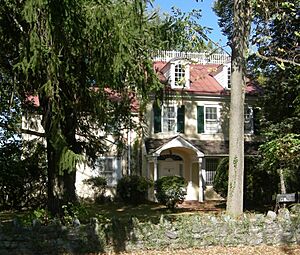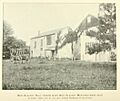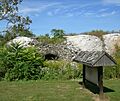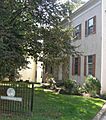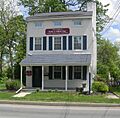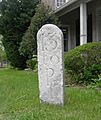Plymouth Meeting Historic District facts for kids
Quick facts for kids |
|
|
Plymouth Meeting Historic District
|
|
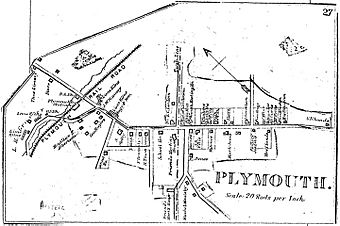
1871 G. M. Hopkins Atlas, plate 27: Plymouth. Germantown Pike is the horizontal road at center; Butler Pike is the vertical road.
|
|
| Location | Plymouth Meeting; Plymouth and Whitemarsh Townships, Pennsylvania |
|---|---|
| Area | 200 acres (81 ha) |
| Architect | Multiple |
| Architectural style | Mixed (more than 2 styles from different periods) |
| NRHP reference No. | 71000715 |
| Added to NRHP | February 18, 1971 |
The Plymouth Meeting Historic District is a special area in Montgomery County, Pennsylvania, United States. It's like a time capsule, showing how a community grew over hundreds of years. This historic district crosses two townships: Plymouth and Whitemarsh.
This district covers about 200 acres (81 hectares) and includes 56 important buildings. These buildings help tell the story of Plymouth Meeting. Some of the most famous buildings here are the Plymouth Friends Meetinghouse (built in 1708), the Livezey House and Store (from the 1740s), and the Hovenden House, Barn and Abolition Hall (from the late 1700s and mid-1800s).
The Plymouth Meeting Historic District was officially added to the National Register of Historic Places in 1971. This means it's recognized as a very important place in American history.
Contents
What Makes Plymouth Meeting Special?
Plymouth Meeting is a village located where the Plymouth and Perkiomen turnpikes meet. In the past, it was known for its stone houses, which were often whitewashed and had nice yards. People thought the village looked very pleasant.
Early History of the Village
Plymouth Meeting is an old settlement, with its history going back almost to the time William Penn arrived in Pennsylvania. It was even shown on a map from 1749! A post office was set up here before 1827, helping the community grow. In 1832, there were only about ten houses, showing how much it has developed since then.
Important Historic Buildings in Plymouth Meeting
The Plymouth Meeting Historic District is home to many buildings that have played a big part in the area's history. Some of these buildings are so important that they are listed separately on the National Register of Historic Places.
Separately Listed Historic Properties
These buildings are especially important and have their own historical recognition:
- Plymouth Friends Meetinghouse (built in 1708): This historic meetinghouse is located at the southwest corner of Germantown and Butler Pikes. It was a central place for the Quaker community.
- Hinterleiter House (around 1714): Also known as the Dickinson House, this property includes a dwelling, barn, summer kitchen, and smokehouse. Today, it serves as the headquarters for the Plymouth Meeting Historical Society.
- Thomas Livezey House and Store (around 1740 and 1788): This building was both a home and a store. It shows how people lived and traded in the past.
- Hovenden House, Barn and Abolition Hall (around 1795 and 1856): This property includes the Samuel Maulsby House and the famous Abolition Hall. Abolition Hall was built in 1856 by George Corson, a strong supporter of ending slavery. It was a meeting place for people who wanted to abolish slavery.
- Plymouth Meeting Country Store and Post Office (around 1826-1827): This building was built by Samuel Maulsby. His son, Jonathan, became Plymouth Meeting's first postmaster here. It was a central spot for the community to get supplies and mail.
Other Notable Properties
Many other buildings contribute to the district's historical feel:
- Journey's End / Plymouth Friends School (around 1827): This building has served different purposes over the years, including as a school.
- Jonathon Jones House (1854): This house is an example of the homes built in the mid-1800s.
- Plymouth Meeting Evangelical Congregational Church (1876-1883): This church is a two-story stone building that could seat many people. It was an important religious center.
- Leedom House (around 1803): This house was home to Dr. Joseph Leedom, who started his medical practice here in 1803. His son and grandson also became doctors.
- Plymouth School House / Williams School (1837): This old schoolhouse shows where children in the area would have learned.
- Maple Hill / Dr. Hiram Corson Residence (1833): Dr. Hiram Corson had his medical office in this house.
Images for kids




